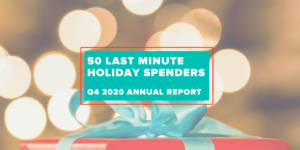
50 Last Minute Holiday Spenders: Q4 2020 Annual Report
Imagine a holiday season with no Black Friday. No literal door-buster deals or live shots of the chaos on the evening news with social distancing measures in place. Large holiday spenders like Walmart, Best Buy, and Target have announced that their stores will be closed on Thanksgiving. They will also limit their early-bird markdowns to prevent huge crowds.
Request the eBook now
We can’t even look at 2019 holiday advertising data to gain an accurate picture of this year’s trends. As with literally everything else, 2020 spending will be based on a very unique set of circumstances.
Through traditional marketing methods, ad impressions typically increase 50% during the holiday season and this year will cover both ends of the advertising spectrum. Some advertisers have already kicked-off the season early (Amazon’s Prime Day was last week, it’s earliest launch to date), while others focus on down-to-the-wire spending.
Last minute spenders are holding out because the markets are shifting weekly.
Most brands have slashed spending this year due to, I don’t know, a pandemic, a recession, an election, and general civil unrest. So, while some big names are spending slowly throughout Q4, others are coming down to the wire before budgets reset in January 2021.
One thing that hasn’t changed is that brands still have to stand out among the crowded landscape of holiday ads. This year that means marketing products that are relevant in our COVID-19 world and sensitive to consumers’ limitations, both financially and geographically.
Getting consumers in the holiday spirit will be a massive undertaking for advertisers. Without traditional social gatherings, shopping environments, or festivities, we can expect more email, social, and digital campaigns to drive e-commerce sales. In fact, according to new research from Salesforce:
- 47% of consumers surveyed are more interested in shopping online.
- 23% are opting for mobile in-app shopping.
- 32% are investing in click-n-collect services.




